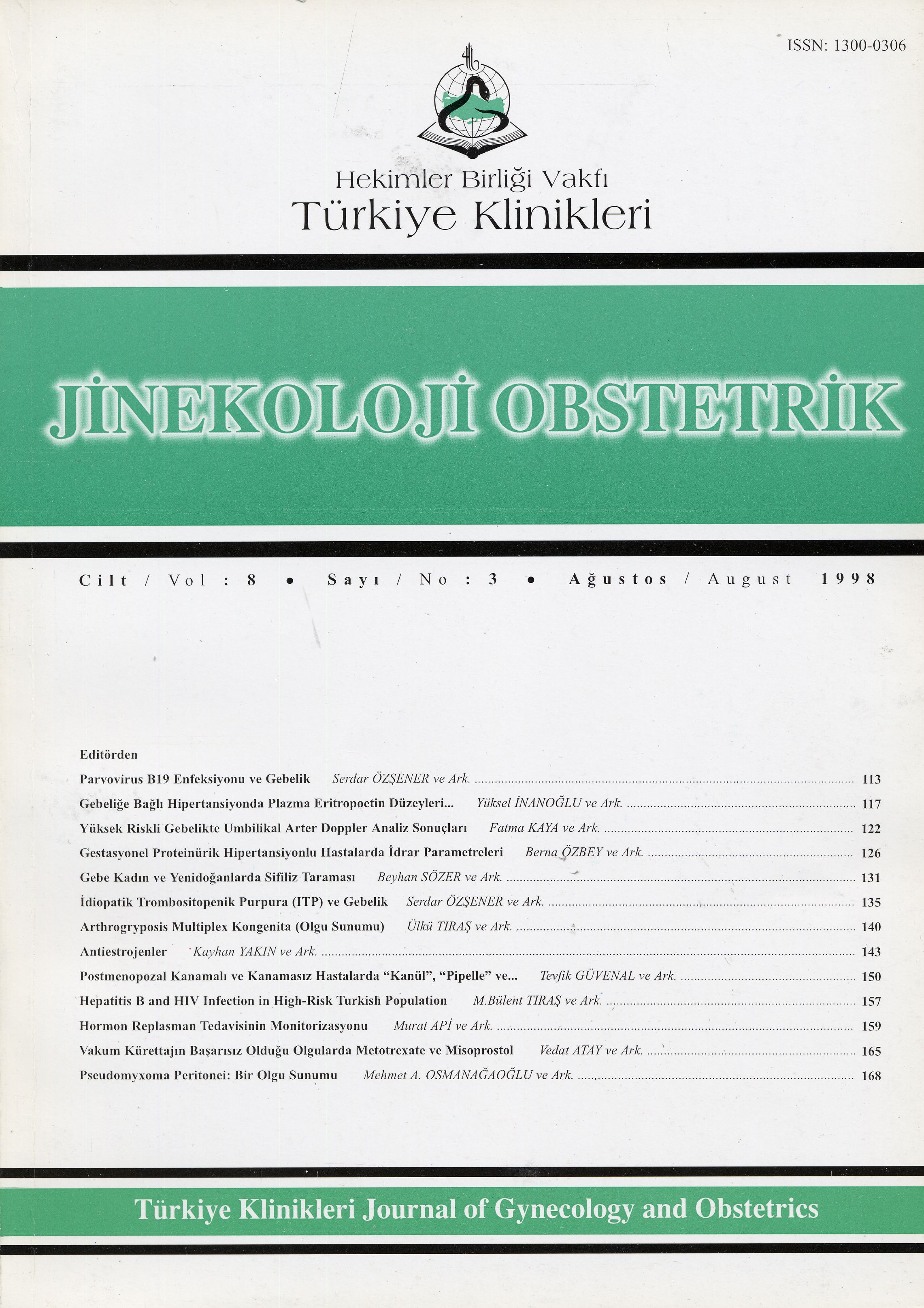Open Access
Peer Reviewed
ARTICLES
3779 Viewed2902 Downloaded
Idiopathic Trombocytopenic Purpura (Itp) And Pregnancy
İdiopatik Trombositopenik Purpura (ITP) ve Gebelik
Turkiye Klinikleri J Gynecol Obst. 1998;8(3):135-9
Article Language: TR
Copyright Ⓒ 2025 by Türkiye Klinikleri. This is an open access article under the CC BY-NC-ND license (http://creativecommons.org/licenses/by-nc-nd/4.0/)
ÖZET
Amaç: Gebelikte idiopatik trombositopenik purpura (ITP)nın tedavisi, doğum yönetimi, anne ve bebek morbidite ve mortalitesi, ilgili literatürler eşliğinde incelenmesi amaçlanmıştır. Çalışmanın Yapıldığı Yer: Ege Üniversitesi Tıp Fakültesi Kadın hastalıkları ve Doğum Anabilim dalı Bornova/İzmir. Materyel ve Metod: 1987-1996 yılları arasında Obstetri polikliniğimize başvurarak, kliniğimizde doğum yapan gebelerin kayıtları retrospektif olarak incelenmiştir. Bulgular: Kliniğimizde 10 yıllık bir sürede 17.200 doğum olgusu retrospektif olarak incelenmiş ve 13 olguda "ITP ve gebelik" saptanmıştır. Görülme sıklığı 1325 gebelikte bir (1/1325) olarak tespit edilmiştir. İki olguda, kliniğe başvurduğunda intrauterin fetus ölümü (IUMF) saptanmıştır. Gebelerin 9 tanesi vaginal yoldan, 4 tanesi sezaryen ile doğurtulmuş, maternal postoperatif komplikasyona rastlanmamıştır. Sağlıklı doğurtulan 11 bebekten, İki bebekte postpartum dönemde neonatal trombositopeni saptanmış, bu annelerin trombositlerinin < 50x 109/L olduğu ve vaginal yoldan doğum yaptığı tespit edilmiştir. Neonatal trombositopeni saptanan ve saptanmayan bebeklerin hiçbirinde trombisotipeniye bağlı intrakranial kanama gözlenmemiştir. Sonuç: Olgu sayısı az olmakla birlikte; şiddetli trombositopenili gebelerin trombosit sayıları ile bebeklerinin trombosit sayıları arasında ilişki olabileceği ancak doğum şeklinin bebekte intrakranial kanama ile ilişkili olmadığı söylenebilir.
Amaç: Gebelikte idiopatik trombositopenik purpura (ITP)nın tedavisi, doğum yönetimi, anne ve bebek morbidite ve mortalitesi, ilgili literatürler eşliğinde incelenmesi amaçlanmıştır. Çalışmanın Yapıldığı Yer: Ege Üniversitesi Tıp Fakültesi Kadın hastalıkları ve Doğum Anabilim dalı Bornova/İzmir. Materyel ve Metod: 1987-1996 yılları arasında Obstetri polikliniğimize başvurarak, kliniğimizde doğum yapan gebelerin kayıtları retrospektif olarak incelenmiştir. Bulgular: Kliniğimizde 10 yıllık bir sürede 17.200 doğum olgusu retrospektif olarak incelenmiş ve 13 olguda "ITP ve gebelik" saptanmıştır. Görülme sıklığı 1325 gebelikte bir (1/1325) olarak tespit edilmiştir. İki olguda, kliniğe başvurduğunda intrauterin fetus ölümü (IUMF) saptanmıştır. Gebelerin 9 tanesi vaginal yoldan, 4 tanesi sezaryen ile doğurtulmuş, maternal postoperatif komplikasyona rastlanmamıştır. Sağlıklı doğurtulan 11 bebekten, İki bebekte postpartum dönemde neonatal trombositopeni saptanmış, bu annelerin trombositlerinin < 50x 109/L olduğu ve vaginal yoldan doğum yaptığı tespit edilmiştir. Neonatal trombositopeni saptanan ve saptanmayan bebeklerin hiçbirinde trombisotipeniye bağlı intrakranial kanama gözlenmemiştir. Sonuç: Olgu sayısı az olmakla birlikte; şiddetli trombositopenili gebelerin trombosit sayıları ile bebeklerinin trombosit sayıları arasında ilişki olabileceği ancak doğum şeklinin bebekte intrakranial kanama ile ilişkili olmadığı söylenebilir.
ANAHTAR KELİMELER: Gebelik; İdiopatik trombositopenik purpura
ABSTRACT
Objective: The aim of the study was to evaluate the therapy, the parturition, the morbidity and mortality of idiopathic thrombocytopenic purpura (ITP) cases of pregnancy with regard to literature. Institution: Egean University Faculty of Medicine, Department of Obstetrics and Gynaecology, Bornova/Izmir/Türkiye. Material and Method: The records of the pregnant patients who have refereed to the obstetry polyclinics and have given birth at our department in between the years of 1987-1996 were reviewed. Findings: 17.200 birth cases in a ten year period were retrospectively reviewed and 13 cases of "ITP and pregnancy" were recovered. The incidence was calculated as one in 1325 births. In the cases in utero mort fetal was diagnosed at their referral. Nine of the cases were delivered vaginally, and four were delivered by caesarean section and there were no postoperative maternal complications registered. Among the 11 live births in two infants postpartum thrombocytopenia were diagnosed .These two women were delivered vaginally and the thrombocyte count were <50x109/L. In none of the neonates intracranial haemorrhage was not diagnosed with or without neonatal thrombocytopenia. Conclusion: Although the number of cases were limited, it was concluded that the thrombocyte counts of the neonates were related with the severity of the thrombocytopenia of their mothers but the mode of the delivery was not found to be related with the intracranial haemorrhage of the neonates.
Objective: The aim of the study was to evaluate the therapy, the parturition, the morbidity and mortality of idiopathic thrombocytopenic purpura (ITP) cases of pregnancy with regard to literature. Institution: Egean University Faculty of Medicine, Department of Obstetrics and Gynaecology, Bornova/Izmir/Türkiye. Material and Method: The records of the pregnant patients who have refereed to the obstetry polyclinics and have given birth at our department in between the years of 1987-1996 were reviewed. Findings: 17.200 birth cases in a ten year period were retrospectively reviewed and 13 cases of "ITP and pregnancy" were recovered. The incidence was calculated as one in 1325 births. In the cases in utero mort fetal was diagnosed at their referral. Nine of the cases were delivered vaginally, and four were delivered by caesarean section and there were no postoperative maternal complications registered. Among the 11 live births in two infants postpartum thrombocytopenia were diagnosed .These two women were delivered vaginally and the thrombocyte count were <50x109/L. In none of the neonates intracranial haemorrhage was not diagnosed with or without neonatal thrombocytopenia. Conclusion: Although the number of cases were limited, it was concluded that the thrombocyte counts of the neonates were related with the severity of the thrombocytopenia of their mothers but the mode of the delivery was not found to be related with the intracranial haemorrhage of the neonates.
MENU
POPULAR ARTICLES
MOST DOWNLOADED ARTICLES





This journal is licensed under a Creative Commons Attribution-NonCommercial-NoDerivatives 4.0 International License.










